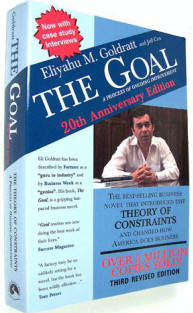You’re only as fast as your slowest process…or Herbie.
 If you have read “The Goal” by Dr. Eli Goldraft then you know who I’m referring to when I say Herbie. For those of you who haven’t read it, Herbie is the slowest kid on a hike with his boy scout troop, and they must stay together, but also get to their campground before nightfall. The only problem is that the entire troop can only go as fast as Herbie can hike. So what do they do to solve this problem? Distribute his load among the fastest hikers.
If you have read “The Goal” by Dr. Eli Goldraft then you know who I’m referring to when I say Herbie. For those of you who haven’t read it, Herbie is the slowest kid on a hike with his boy scout troop, and they must stay together, but also get to their campground before nightfall. The only problem is that the entire troop can only go as fast as Herbie can hike. So what do they do to solve this problem? Distribute his load among the fastest hikers.
The idea behind The Goal Theory of Constraint is strengthening your weakest link. And when that weakest link is stronger, another one appears, and it becomes a cycle. The Theory of Constraint (TOC) involves the bottleneck theory, or problem areas in your processes so that you can improve them. It points out that every system has constraints, whether it’s people, equipment, policies, procedures, supplies-internally or externally. This theory can be used to identify the constraint in a particular process, and then discover different methods or ways to carry it out, in order to improve or maximize time, production, employees, etc. TOC relates to Lean Manufacturing concepts that have been around for decades.
There are several different methods to help analyze and find bottleneck areas, but one of the most efficient ways is to conduct time studies. Yes, this can be very tedious, but the data that you will collect will be reliable and accurate. You at least want to track a 48 hour time period, but naturally the longer you can do the time study, the more accurate your data will be. Reliable data always gives you a good basis for moving forward.
When conducting time studies, it’s a good idea to dedicate one person to follow an employee to watch, observe and track everything that they do during their shift and when they change tasks. If it’s at least one minute, capture what the operator is doing, whether it’s hooking up chains, unloading, loading, welding, etc. You can have multiple time studies going on at once, but just make sure to keep one person allocated to tracking so the data is accurate. An easy way to keep up with this data is to create a time study spreadsheet in excel and plug in what time the shift started, what time it ended, tasks, total time of each task and reasons. Once you have collected all your data, the next step is to summarize and analyze.
Summarize your data so that you can step back and look at it and ask yourself “what can we do to improve?” You’ll come up with a whole list of “what if’s,” but just tackle them one at a time based on which ones have the biggest impact. This might lead to hiring more employees, installing new equipment or even something as simple as moving equipment around to make the process smoother. It’s just reevaluating and looking closer at current conditions to find the bottleneck areas, and then coming up with action plans to improve the process.
5 Step Process
1.Determine that a process is a bottleneck
2. Conduct a time study of every minute of every shift for a prescribed amount of time-no less than 48 hours
3. Summarize and analyze data to see what issues you can address
4. Develop action plans to address the most significant issues
5. Put together the right team to carry it out
After a few months, you need to reevaluate again to see if your changes did indeed give you the results you were looking for. Eventually you could get to a point where you exhaust your resources for only a small gain. That’s when the analysis is really important: you’re not exactly where you want to be, but you can’t figure out a cost-effective way to go much further, so that’s when reevaluating and time studies come back into play. Yes, you’ll start the cycle again, but you will also move up a level each time.
Once you complete that next time study, you’ll come up with another list of improvements, so you’ll need to make sure to do a cost-analysis to make sure that you are getting a return on your investment. You’ll need to decide if the time saved covers the cost.
3 Benefits:
1. Actually know how the time is being spent.
2. The analysis tells you where you need to apply your resources
3. Follow up to make sure you’re resource allocation was successful/profitable
We would love to here your thoughts. Use the comment section to let us know what you think and how TOC has worked in your organization.
